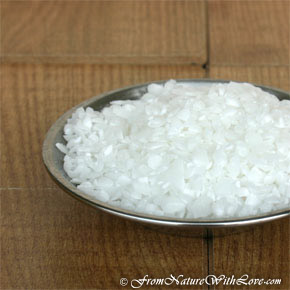I get dry skin, so I use a moisturiser to stop it getting dry and itchy. Here is a picture of me with a blob of moisturising cream on my nose.
It's not a good look, is it? But it does smell nice, because I made it myself. Here is a picture of the cream in the pot. It's shame you can't smell it.
The ingredients of any moisturising cream are quite simple really. It's basically made of oil and water. You can use any oil, just not the kind you put in your car engine. And you can use any type of water: spring water, rose water (that's the stuff that gives turkish delight its smell and taste) or even tea, without milk and sugar of course.
The tricky bit comes when you mix your oil and water together. Why? Let's try. (ASK FIRST)
Get a glass of water and pour a teaspoon of cooking oil from the kitchen cupboard into it. Look carefully.
What has happened? Can you dip your finger in a touch just oil? Or just water?
It doesn't look creamy and blobby like my moisturiser, does it? The thing is, oil and water don't mix. The molecules that make up oil and water repel each other.
What's repelling? Think about two magnets, they either pull together or repel each other so they are pushed apart. (TRY IT)
Oil and water don't want to get mixed up to make my moisturiser. So I add an emulsifier. Let's look up emulsifier in the dictionary. Mine says,
"Generally, any ingredient used to bind together normally noncombinative substances".
What does yours say?
So it's something we can add to make oil and water emulsify, or break up into teeny little bits that will make a smooth, creamy mixture. Nice and smooth, so I can rub it into my skin. I use an emulsifying wax. It looks like this:
Looks a bit like rice doesn't it?
You can make oil and waters mix using force too. We don't usually encourage that do we?
Shall we make an oil and water emulsion in the kitchen? One that you can use at home? It's actually a nice thing to make, but do ask someone before you do it.
Let's make salad dressing (also called vinaigrette).
You need:
1 part vinegar : 3 parts oil (olive or sunflower or any kind of cooking oil)
That means for every one amount of vinegar you add three of oil, giving you four parts altogether.
So, 1 spoon of vinegar and 3 spoons of oil, gives you 4 spoons of salad dressing. Or 1 litre of vinegar to 3 litres of oil (DO NOT MAKE 4 LITRES OF SALAD DRESSING AT HOME. YOUR FAMILY WILL NOT THANK YOU).
So if we use 50ml of vinegar, how much olive oil do we need?
- Put your chosen amounts of oil and vinegar into an empty jar. You need one with its original lid.
- Add some other ingredients for taste - salt, pepper, a small spoon of mustard, any herbs you like. Not jam. Jam does not taste good in salad dressing.
- Look in the jar. What do you see?
- Now. Put the lid on the jar very very tight. Shake the jar as hard as you can. What can you see now?
- After a really good shake you will have a thick, slightly gloopy looking liquid. The oil and vinegar have been forced to mix. You have emulsified them. You can now put your dressing on any kind of salad and eat up.
Do not put salad dressing on your nose though. It won’t feel nice.
Emulsifiers used as additives will have an E number. All food additives have an E number. See if you can find what range of E numbers are used for emulsifiers.
Extra thinking...
Emulsifiers are often used as additives in food. Anything that needs to stay nice and thick and gloopy will have an emulsifier in it. Look at some food labels, are there any emulsifiers in the ingredients? What are they?

No comments:
Post a Comment